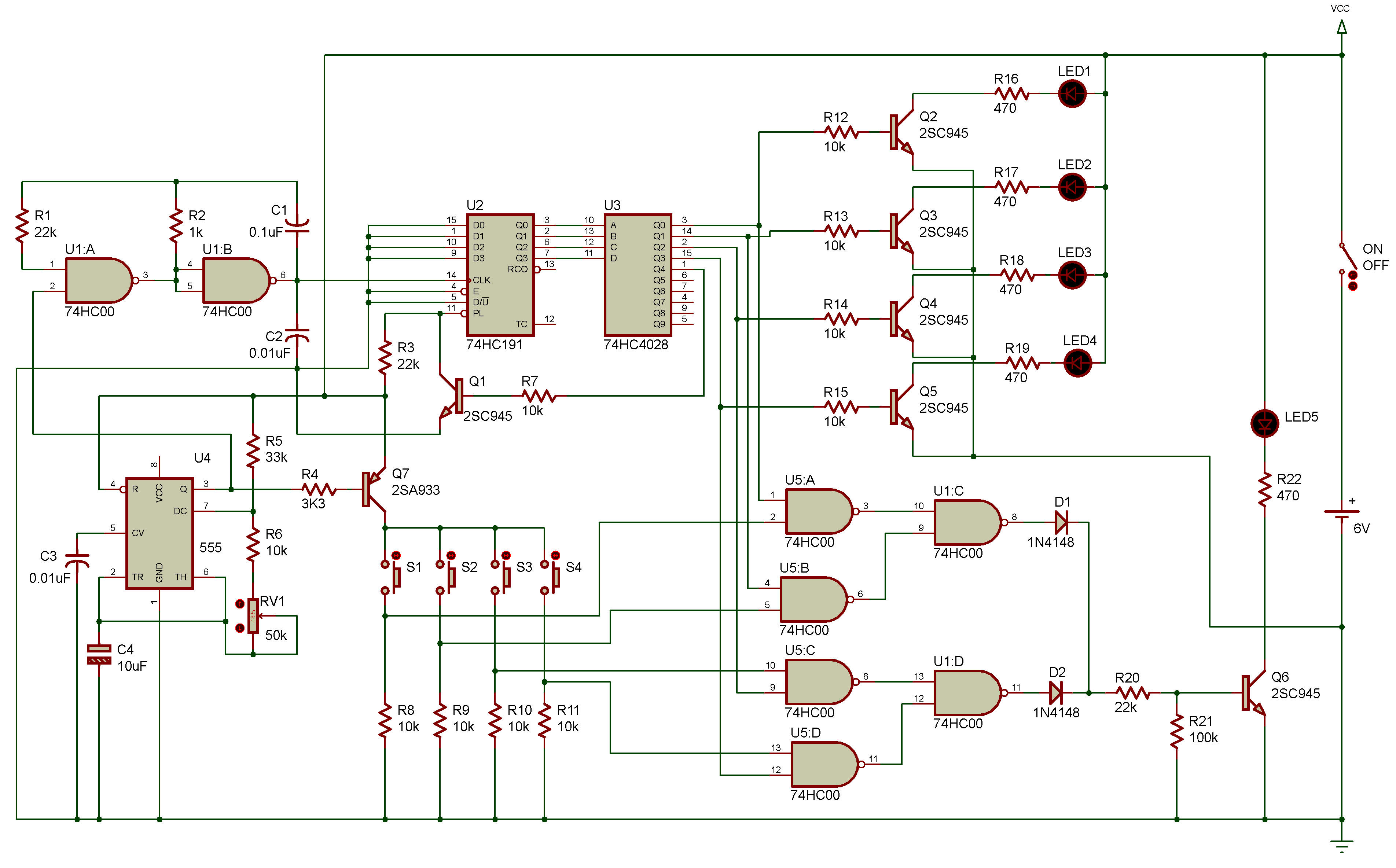
Reflex nerve test game
555, 74HC00, 74HC191, 74HC4028
In this project, you're going to make a circuit that tests your reflex nerve. You pass the test if you catch LEDs that light at random times. LEDs light one by one. Does your nerve respond fast enough to catch them up?
Why don't you compete with your friend!
When you finish wiring, turn power ON.
LEDs 1-4 flicker in rapid succession, and one of them stays lit for a certain time. Find this LED and press the key, S1 - S4, that corresponds to the LED.
For example, when LED 1 lights, press S1. If you pressed the right key, LED 5 lights up. After a time, the four LEDs turn back to flickering (and LED 5 goes out) for the next round.
The control volume can be rotated to change the flickering-to-lighting cycle.
U4 555 is an oscillator, which determines the flickering-to-lighting interval of LEDs. While the output of U4 is H, the NAND multivibrator U1 oscillates at approx. 40 Hz.
The quaternary counter U2 counts up with the oscillating output from U1.
The output of U2 is decoded by the decoder U3, which causes LEDs 1 - 4 to flicker one by one. When the output of U4 changes to L, the counter stops, so one of the LEDs shifts to continuous lighting.
Now, the keys are enabled. If the key corresponding to the currently lighting LED is pressed, a connection is made through the gate circuit U5 to LED 5, which thus lights up.
| Bill Of Materials For Reflex nerve test game.DSN | |||||
| 22 Resistors | |||||
| Quantity: | References | Value | |||
| 3 | R1, R3, R20 | 22k | |||
| 1 | R2 | 1k | |||
| 1 | R4 | 3K3 | |||
| 1 | R5 | 33k | |||
| 10 | R6-R15 | 10k | |||
| 5 | R16-R19, R22 | 470 | |||
| 1 | R21 | 100k | |||
| 4 Capacitors | |||||
| Quantity: | References | Value | |||
| 1 | C1 | 0.1uF | |||
| 2 | C2, C3 | 0.01uF | |||
| 1 | C4 | 10uF | |||
| 5 Integrated Circuits | |||||
| Quantity: | References | Value | |||
| 2 | U1, U5 | 74HC00 | |||
| 1 | U2 | 74HC191 | |||
| 1 | U3 | 74HC4028 | |||
| 1 | U4 | 555 | |||
| 7 Transistors | |||||
| Quantity: | References | Value | |||
| 6 | Q1-Q6 | 2SC945 | |||
| 1 | Q7 | 2SA933 | |||
| 2 Diodes | |||||
| Quantity: | References | Value | |||
| 2 | D1, D2 | 1N4148 | |||
| 12 Miscellaneous | |||||
| Quantity: | References | Value | |||
| 1 | + | 6V | |||
| 5 | LED1-LED5 | LED-RED | |||
| 1 | ON | OFF | |||
| 1 | RV1 | 50k | |||
| 4 | S1-S4 | BUTTON | |||
